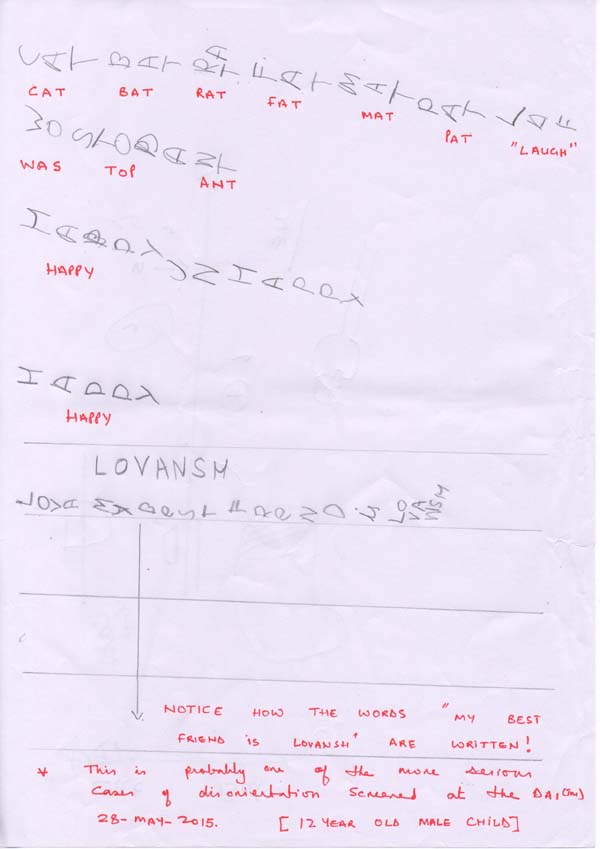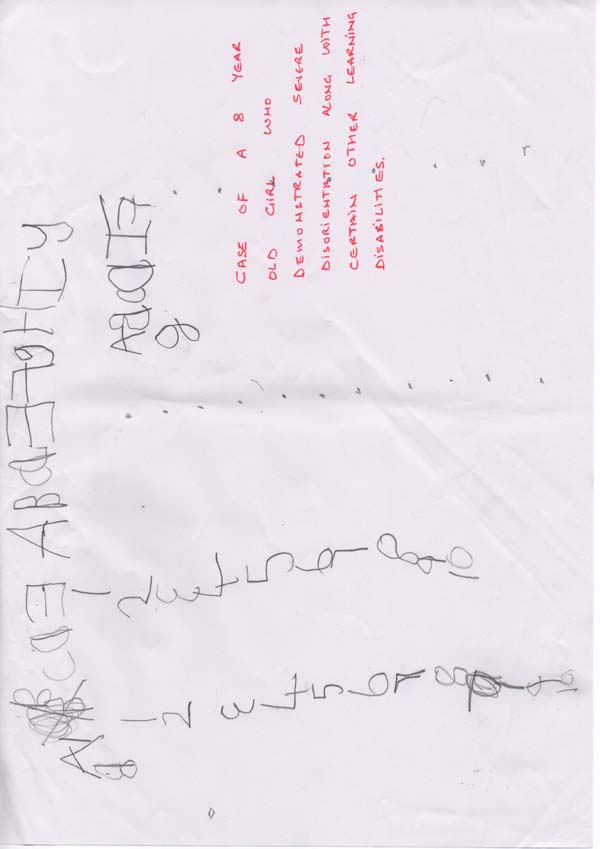Time ( 10AM to 8 PM )
Disorientation & Developing Dyslexia
We know are clear that dyslexia is a multifactorial trait in which genetic vulnerabilities interact with other cognitive skills and environmental factors to produce an increased risk of being unable to read and write in a continuous way. We have observed that when left unattended for a long period of time the level of risk that the child faces reaches a certain threshold, and the classic dyslexia profile emerges.
Of special interest within this category are children who have at least average intelligence, and who do not have general learning difficulties, and whose reading problems are not due to extraneous factors such as SA deficits, socioeconomic disadvantage etc.
The problem related to reading in this category can show up in extreme difficulties in acquiring basic reading sub skills such as identifying words and understanding the letter to sound phenomenon and correctly sounding out words and this tends to be accompanied by specific deficits in cognitive abilities related to reading and other literacy skills.
The disorientation that such children face and the conceptualizations specifying their cognitive and neuro-biological deficits that underlie their academic and reading problems have in our opinion a causal relationship between their innate skills and abilities that are supposed underlie their ability to learn to read, and their actual reading ability that is clearly visible.
Perception, specially that which is visual in origin and also memory which is primarily verbal causes a possible lack of understanding in the brain how to process the information coming from the outside word via the medium of visual inputs.
Some children are not able to generate the transformations, which are necessary to localize visual targets.
A neural substrate that presumably supplies the stimulus about whether any action, mental or physical, is required in relation to an object as a result of the identification may not be working in harmony.
These disoriented children can suffer from not being able to stabilize and process how objects are localized in and around them specially when it comes to seeing words. So the consequence of this can be that they are not able to realign their sight related abilities and the inability to explore their immediate environment and location related deficits leads to an inability to orient where letters and words are.
There is no transformation of the print into real time spatial coordinates leading to disorientation between the ocular motor – head – body motion sequence. The net result is a deficit of motor related sequences, which create confusion between retina obtained images and motoric signal transmission. Visual direction if it needs to be accurate has to be backed by accurate direction of attention.
But for some children such as the child who wrote this page in our clinic the efficient transformation of retinotopic input into real-space co- ordinates does not happen.
(1)

With delayed or deficit related analogous transformation of the somatic sphere, the touch ability is also affected and a disconnect between spatial understanding of the position of the limb and the position of the letters and words and where the fingers have to fall to commence the process of transforming thought to word gets affected.
(2)

Because of disorientation such as faced by this child whose sample is attached below the preliminary localization operations are not completed by certain mechanisms and the perceptual system cannot and has not generated the information needed for accurate motor and spatial control.
(3)

A complex delay in signal transmission between different brain systems that is needed to help guide eye, head, body or limb movements does not occur and accurate track of the position of the reading and subsequent writing does not unfold.
There are children who progress through intellectual milestones at a rapid rate than their peers but the experience of being different with acute awareness of the pain and suffering of being unable to make sense can lead to such children feeling distinctly disadvantaged.
Achievement, particularly individual achievement for school going children, is quite often culturally determined as academic developmental advancement. There will always be children who develop at a faster pace - are inquisitive to a greater degree - generalize concepts earlier and demonstrate advanced verbal or spatial capacities at an early age. They can also be extraordinarily insightful, have a passion for academics and be profoundly aware.
A lot of children with the level of disorientation shown above have good verbal ability, which is a potent indicator of school success but does not predict scholastic proficiency. It correlates with the complexity of one's thought processes.
The intensity of the phenomenon of disorientation shown above leads us to speculate that it is undergirded by a structural and/or functional difference in brain development resulting in neurological biodiversity and unusual mental processing that constitutes the core of Learning Disabilities.
Learning Disabilities can be in our personal opinion asynchronous development in which advanced cognitive abilities and heightened intensity have not combined to create inner experiences and lower level processes in the brain for the stage and age that are qualitatively perfect and as a result of this the higher level processes are not different but at a low average norm.
This asynchrony increases with higher intellectual demands on cognitive capacity leading to a breakdown of processes required for reading and writing correctly.
Disoriented and Learning Disabled children can be very vulnerable and require modifications in parenting, teaching and counseling in order for them to develop optimally.
Probably the emphasis on marks, talent, and success in academic life is just the tip of the iceberg of the problems these children with disorientation and who struggle to learn to read and write face and a vast, uncharted territory of worry, concern, anxiety, and fear lies beneath the surface.
It is about time that parents gave a thought to the real life experience of their children and tried to see the world through their ‘eyes’ rather than ‘hope’ that all will work out well or ‘believe’ that nature will resolve the problem with time.
To understand whether your child is suffering silently from a sense of disorientation in the school and a feeling of being lost in his/her world which is making no sense to her or him - make an appointment with the DAI™ please call us on +91 – 8826022886 or e mail us for an appointment on
info@dyslexiaindia.org.in
As at the Dyslexia Association of India™ we have a strict policy to comprehensively check and diagnose only one child per day.
Any payment that is made for your appointment at the DAI™ qualifies for exemption from Income Tax (IT) and parents are provided a Section 80G receipt so that they can use it when filing their Income Tax Returns.
* Opinions and information expressed by the DAI™ are equivocal and personal to the researchers and specific to the organization.